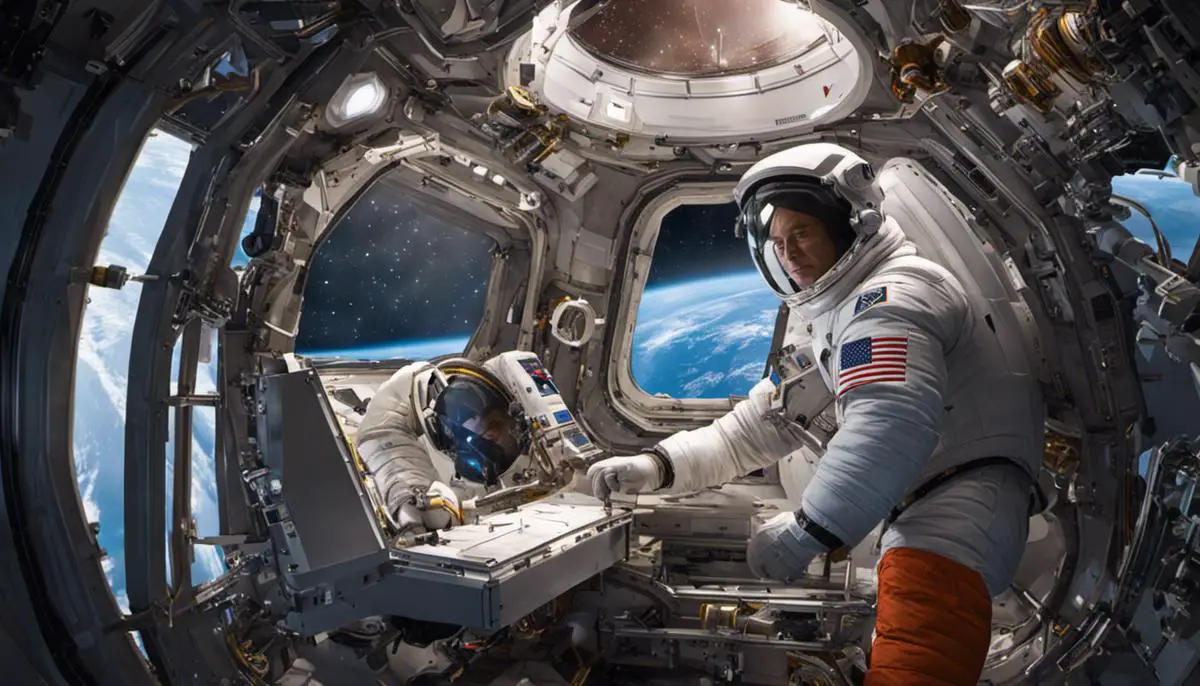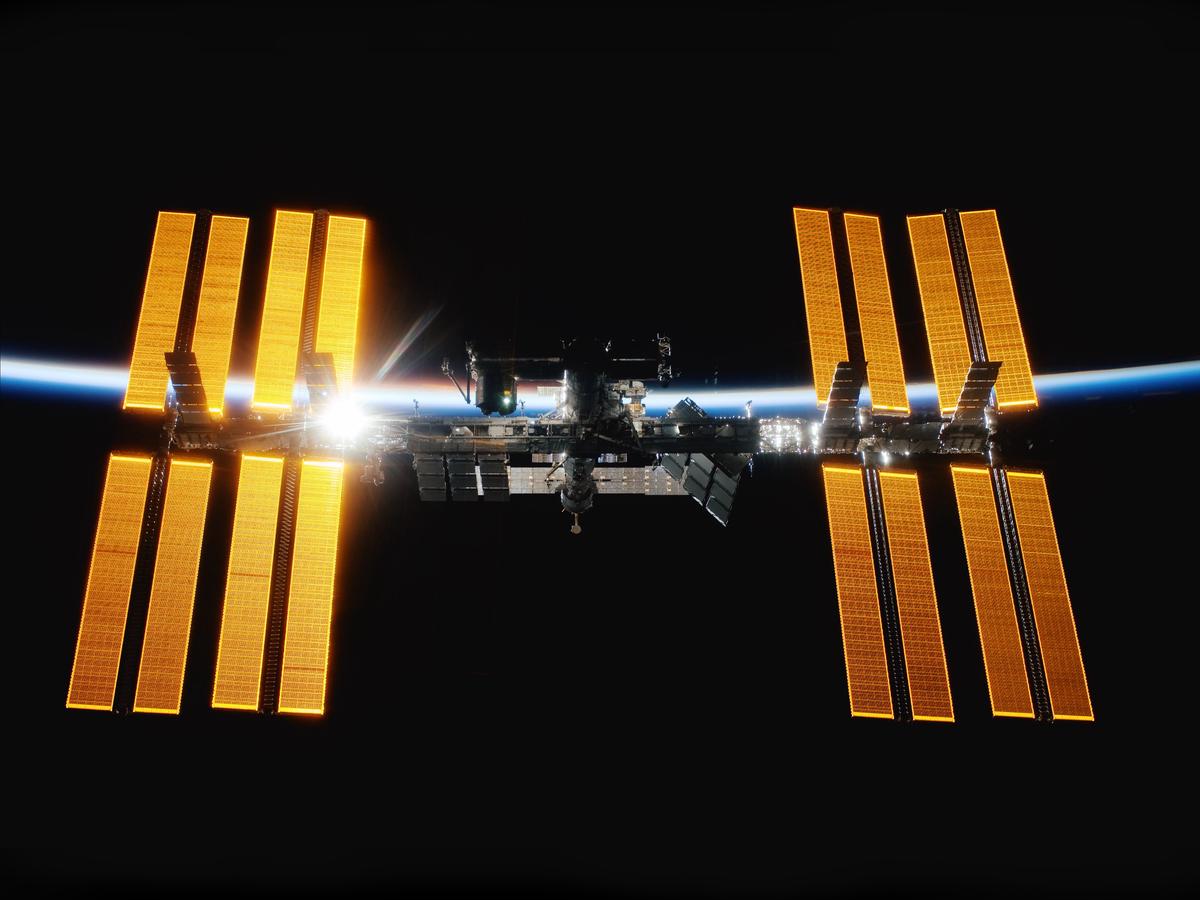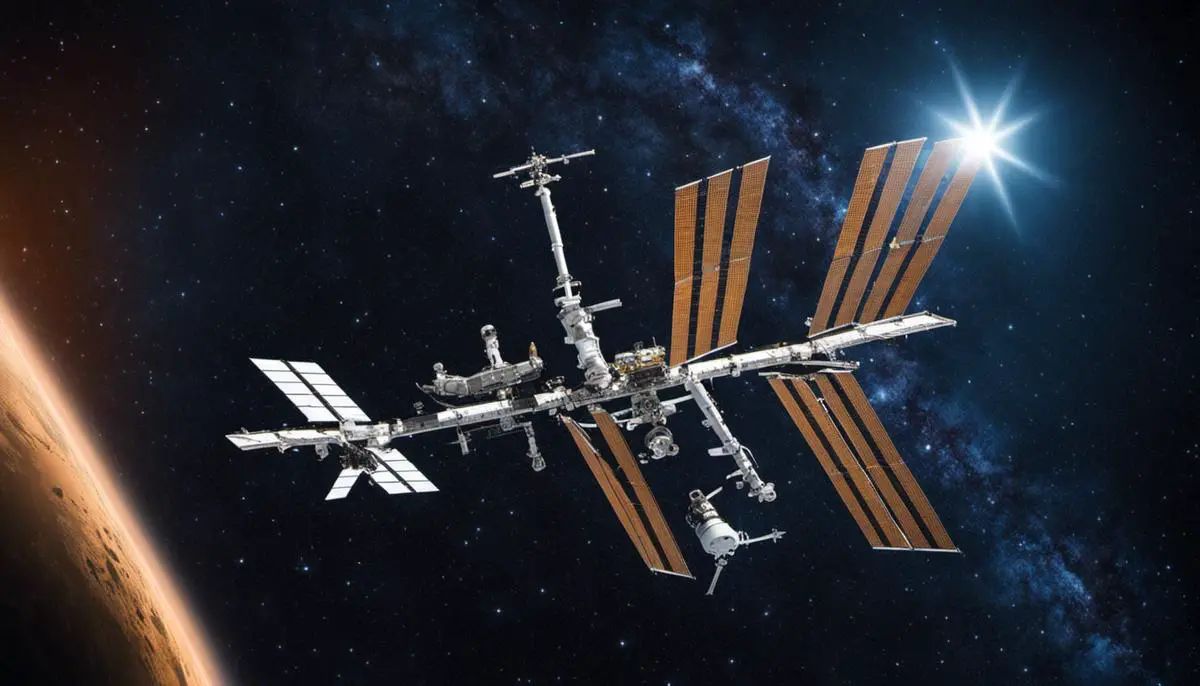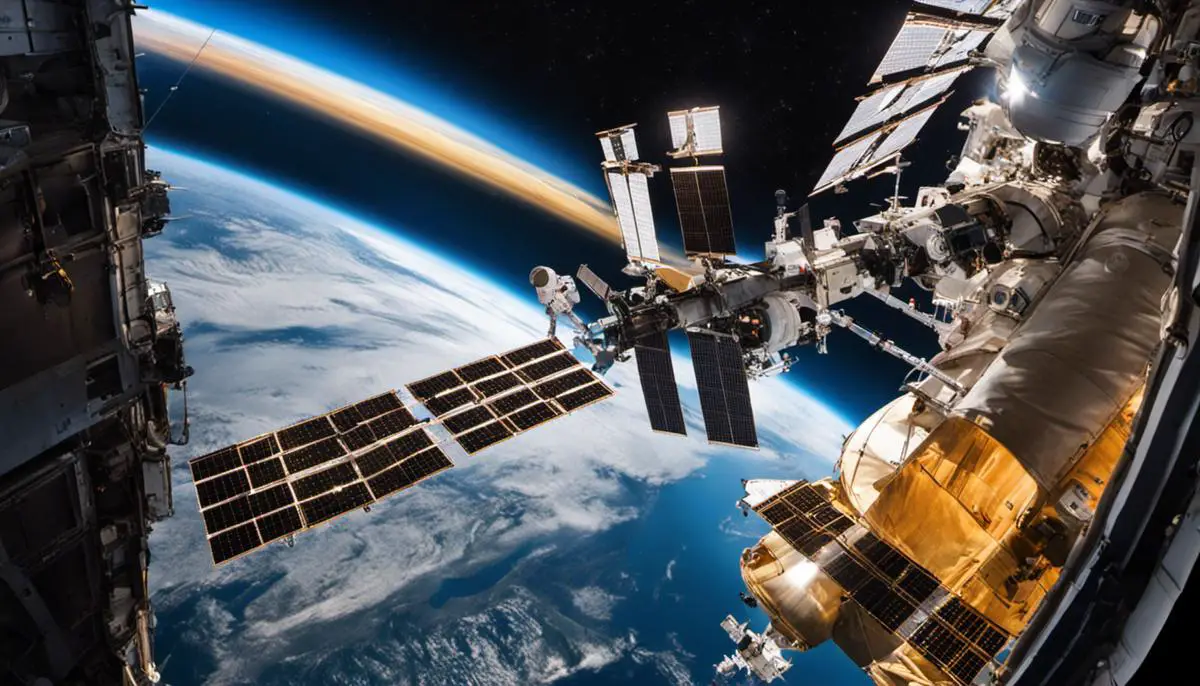The International Space Station (ISS), an orbiting emblem of international collaboration and space exploration, serves multifaceted purposes and objectives. It is both a home floating in space for astronauts and an unrivaled laboratory for conducting unique space-based research. With various nations united in their shared ambition to decipher the mysteries of the universe, the ISS underlines the epitome of human innovation and curiosity. Inhabits of the ISS, astronauts, engage in a life far removed from our terrestrial habits. Their existence in a zero-gravity environment necessitates comprehensive adaptations in basic activities including eating, sleeping, maintaining health and hygiene. Along with this fascinating insight into space life, the ISS also stages ground-breaking scientific experiments influencing our grasp of space and its effects.
Purpose and Objectives of the International Space Station (ISS)
Purpose and Objectives of the International Space Station
At the heart of the International Space Station’s purpose lies an objective to facilitate research opportunities that lead to innovative advancements in technology and science. As a unique, microgravity platform, the ISS allows various crucial experimentations to occur in fields such as biology, astronomy, and physics, studies that otherwise would not be possible on Earth. This way, the station provides an establishment for enhancing our understanding of various scientific phenomena.
Experiments done aboard the ISS address challenges related to human health, both in space and on Earth. With long-duration spaceflights becoming frequent, understanding how microgravity affects the human body is essential. Some significant research areas include bone and muscle loss, risk from cosmic radiations, and the psychological effects of confined spaces and isolation. These findings are valuable not only for future astronautic missions, particularly long-term ones like those to Mars, but also to improve health treatments back on Earth.
Moreover, the ISS functions as a test bed for technology and spacecraft systems necessary for space exploration. New technologies are constantly tested on the ISS before they find application on other spacecraft or future manned missions. Operating and maintaining the station also teaches us how to deal with challenges that come with living and working in space.
International Cooperation in the International Space Station
The ISS’s existence showcases the power and success of international collaboration. Several countries, including the United States, Russia, Canada, Japan, and multiple European nations, have come together to create, maintain, and staff this unique platform. This cooperation has not only resulted in the creation of the ISS but its successful operation, leading to numerous scientific breakthroughs, and it continues to play a pivotal role in maintaining peace among these nations.
Different countries regularly launch their astronauts to the ISS and utilize the facility for their research. This reflects the global nature of the space station, where cooperation trumps competition. By creating opportunities for shared resources and knowledge, the International Space Station stands as a symbol of unity among nations in the global pursuit of discovery.
Life on Board the International Space Station
The International Space Station (ISS) does not just function as an orbiting laboratory; it also serves as a home for its crew members. Engineered with advanced systems, the ISS provides all the essential requirements for human survival. These include oxygen supply, sustenance, hydration, and waste management systems. The ISS has been designed to support prolonged stay in space by its crew, and as a result, serious efforts have been made to replicate conditions conducive for human life. This includes the construction of sophisticated life support systems and comfortable living quarters where astronauts can eat, sleep, and exercise.
The existence and functionality of the International Space Station underscore the incredible feats that humans can achieve when united in effort. As a pivotal instrument for space exploration and international collaboration, the ISS is a symbolic beacon that continually expands the boundaries of human understanding about the universe.

Living and Working in Space: Life on the ISS
A Typical Day on the International Space Station
Keeping their physical and mental health in mind, astronauts on the International Space Station (ISS) follow a carefully planned schedule that closely mirrors a typical day on Earth. Each astronaut is accorded 8.5 hours of sleep and 2.5 hours of physical exercise each day. This physical routine also includes an additional half-hour dedicated to hygiene post-exercise. Since the absence of natural day-night cycles in space can confuse the human sense of time, the space station operates according to Greenwich Mean Time to maintain a consistent time structure.
Eating in Space
The manner in which astronauts consume food in space is quite distinctive due to zero gravity conditions. Foods are mostly dehydrated and stored in vacuum-sealed pouches. They are rehydrated with a water dispenser before eating. Astronauts also have thermostabilized meals which are heat-treated to destroy harmful microbes and enzymes. Aquatic foods such as shrimp are thermostabilized, so they can be eaten straight from the pouch.
Sleeping in Space
When it’s time for sleep, astronauts need to adjust to a completely new environment where they can’t lie down or feel the pressure of a mattress. To sleep, astronauts will often fasten their sleeping bags to the wall or ceiling of their small, personal quarters to stop themselves from drifting around. The station is never completely dark, nor is it silent, so astronauts use eye masks and earplugs to simulate night-time and block out constant noise.
Working in Space
Astronauts have duties such as maintenance work, research experiments, exercise, connecting with the public through outreach, and participating in media interviews or conference calls. They also participate in spacewalks to conduct experiments that require the unique conditions of space or to repair, maintain or upgrade the space station.
Health and Hygiene in Space
Hygiene in space is challenging due to the lack of gravity. Astronauts use specially designed devices for brushing teeth or bathing. Water doesn’t flow in space, so astronauts use a waterless shampoo and a specially designed squeeze bottle for washing their bodies. Toilets on the ISS use airflow to direct waste into containers, which are eventually sent back to Earth for disposal.
Adapted Technologies and Methods
Astronauts use a variety of technologies to adapt to life in space. For instance, rather than traditional pens that rely on gravity to feed ink, they use specially designed space pens that use pressurized gas. Cutting-edge technology also aids astronauts in conducting scientific research. For example, the ISS is equipped with a glovebox—a sealed container equipped with gloves—which allows astronauts to conduct experiments involving potentially hazardous materials without risk of contamination.
Functioning in a zero-gravity environment
Functioning in a zero-gravity environment requires novel solutions to everyday tasks and challenges. Astronauts have adapted physical workouts to maintain muscle strength and bone density in the absence of gravity. They use resistive exercise devices that simulate the effect of gravity and allow them to “lift weights” in a weightless environment.
Understanding the Role of the International Space Station
The International Space Station (ISS) is more than a hub for scientific experiments and research. It stands as a symbol of human ingenuity, adaptability, and our unwavering spirit for exploration and discovery. The advancements made in sustaining life on the ISS are setting the stage for extended space expeditions, possibly even paving the pathway for humans to inhabit other celestial bodies.

Scientific Research and Experiments Conducted on the ISS
The ISS – An Extraordinary Orbiting Laboratory
The ISS essentially serves as an unparalleled orbiting laboratory, delivering an invaluable platform for comprehensive scientific research in a vast array of fields such as biology, physics, astronomy, and meteorology. With its unique microgravity environment and exposure to outer space conditions, it offers scientists the opportunity to conduct research and experiments which wouldn’t be feasible on our home planet, thereby significantly enhancing our understanding and comprehension of space.
Impact Of Space On The Human Body
One of the main aspects of research on the ISS is studying the effects of long-term space exposure on the human body. Astronauts on the ISS engage in a variety of experiments to study how life in space impacts their physical and psychological well-being. This includes studying bone density loss, muscle atrophy, changes in vision and sensory perception, cardiovascular deconditioning, sleep disturbances, and radiation exposure. The findings from these experiments not only deepen our understanding of how humans can safely and effectively spend extended periods in space, but they also have applications to health and aging on Earth.
Studying Celestial Bodies: Astronomy and Earth Science on the ISS
The ISS also plays a crucial role in advancing our understanding of Earth as well as the wider universe. The station’s unique vantage point in low Earth orbit allows for detailed observation and study of celestial bodies and astronomical phenomena. Astronauts and robotic instruments aboard the ISS have been involved in a range of astronomical observations, from surveying distant galaxies and mapping dark matter to studying the sun, the Earth’s atmosphere, and natural disasters such as hurricanes and forest fires.
Ground-Breaking Experiments that are Impossible on Earth
In its microgravity environment, the ISS allows for unique experiments in a variety of scientific fields. For instance, investigations into fluid physics can yield insights into how fluids behave in the absence of gravity, potentially improving the design of fuel systems and other fluids-related technology. Researchers on the ISS are also growing crystals that are more perfect than Earth-based versions, with implications for drug design and synthesis. Other experiments have delved into quantum physics, using the cold and secluded environment on the ISS to test the fundamental laws of reality in ways impossible on Earth.
Outcomes and Impacts on our Understanding of Space
The research and experiments conducted on the ISS have profoundly impacted our understanding of space and life on Earth. The study of human health and physiology in space has informed plans for future long-duration space missions, including those heading towards Mars. The station’s Earth observations have provided significant data for climate studies, disaster response, and other Earth-focused research. The fundamental science performed on the ISS has also driven innovations in a host of sectors, including medicine, agriculture, technology, and physics.
As a unique and multipurpose orbiting laboratory, the International Space Station continues to expand human knowledge, fostering international cooperation and paving the way for future space exploration.

As the hallmark of human ambition reaching for the stars, the ISS continues to profoundly shape our understanding of life beyond Earth. The knowledge gained from crisscrossing various scientific disciplines on the ISS has had cascading influences on our daily lives and scientific advancements. The research conducted aboard expands our intellectual horizon, spanning from understanding the impact of space on the human body, to studying celestial bodies, to conducting experiments deemed impossible under Earth’s gravitational pull. The shared research interests and international cooperation reveal the potential of humanity’s reach when unified in purpose, thereby redefining our future in space. As we step into a new space age, the ISS continually serves as a beacon, hinting at staggering possibilities and enlightening futures that lie beyond our terrestrial confines.
![]()
